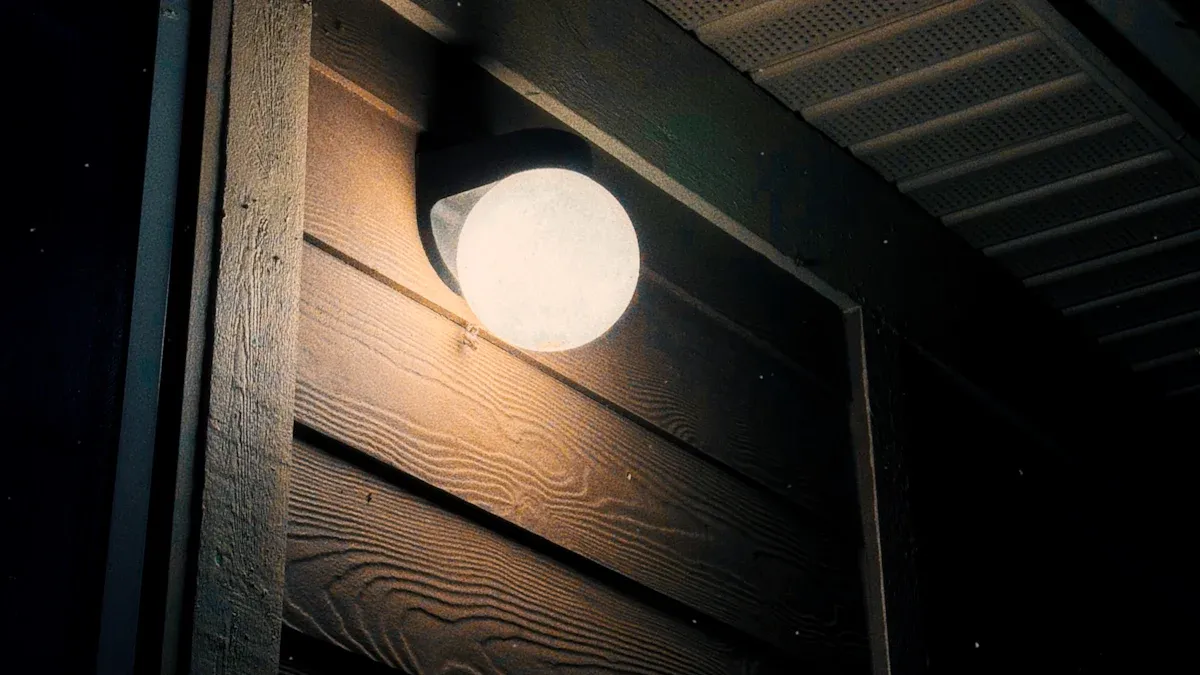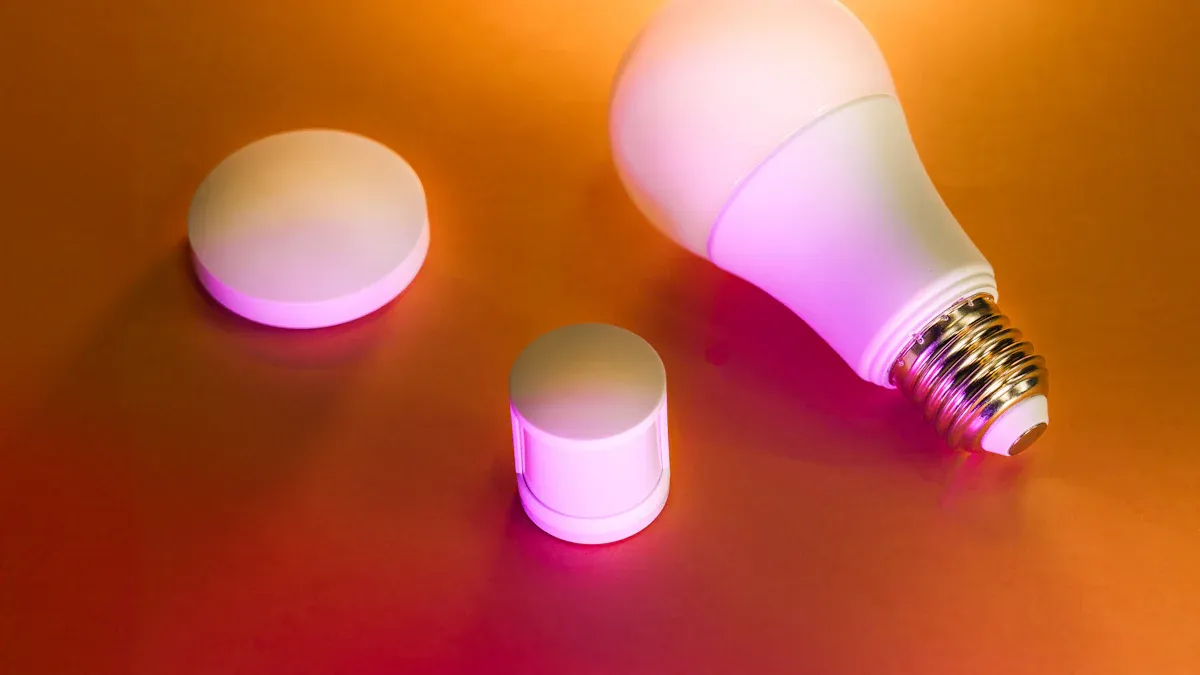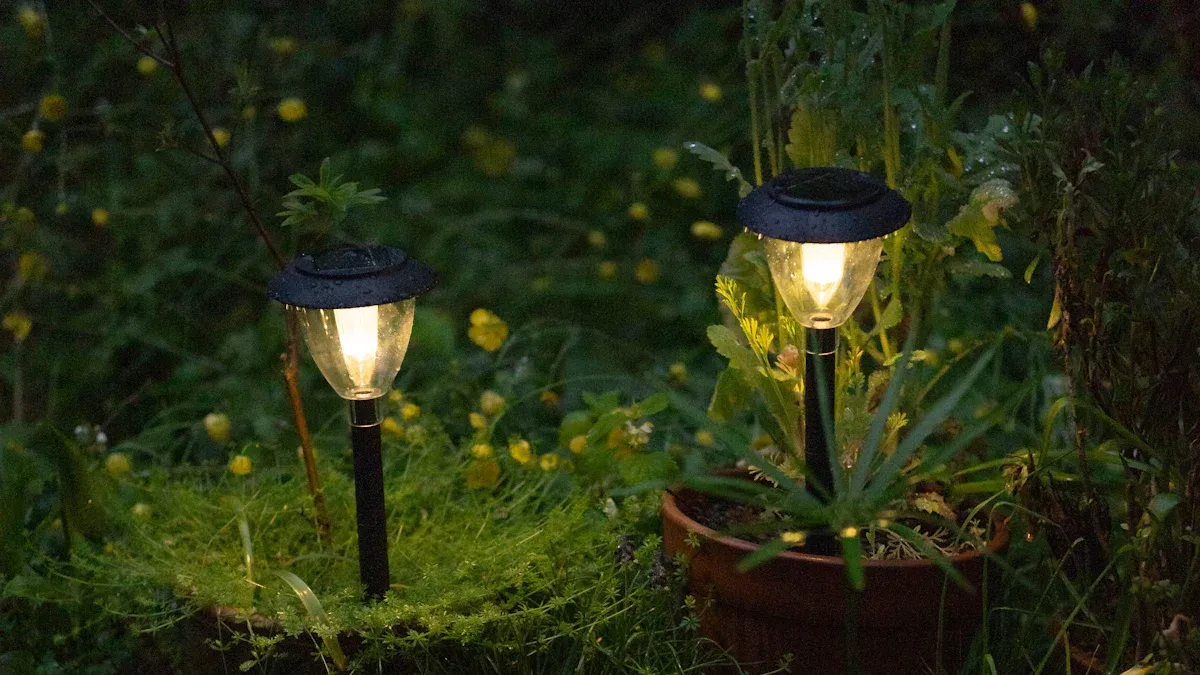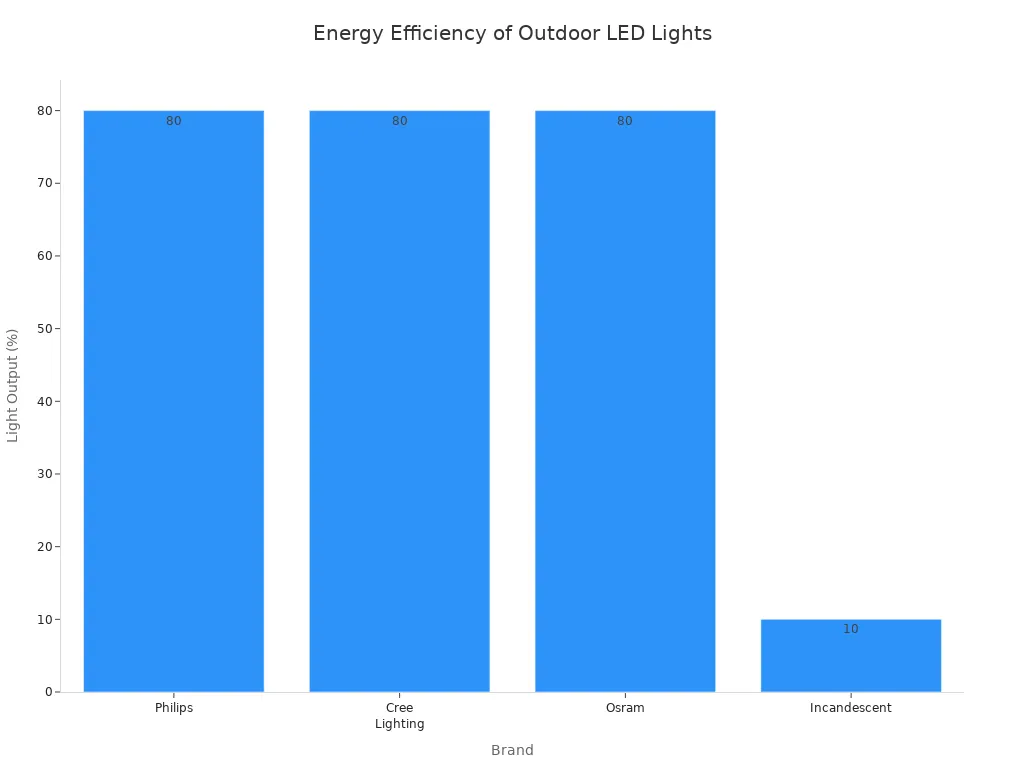Choosing the Right LED Lights for Outdoor Fixtures: Brightness, Color Temperature, and Durability

What matters most when you choose the right LED lights for outdoor fixtures? You want your home to look great and feel safe. Maybe you dream about relaxing on a new patio or want to boost curb appeal with fresh plantings. Many people plan to add outdoor lighting, update decks, or grow gardens this year. You need to match brightness, color temperature, and durability to your specific needs. If you understand lumens, color temperature, and weather resistance, you can pick the best product for every space. About us—helping you make smart choices for outdoor lighting!
Key Takeaways
Learn about lumens to know how bright lights are. Pick 200-400 lumens for a soft glow. Use 800 or more lumens for safety.
Pick the best color temperature for your space. Warm white (2700K-3000K) makes things feel cozy. Cool white (4000K-5000K) helps you see better.
Look at the IP rating to check if lights handle weather. IP65 or higher means lights can stand up to rain and dust.
Choose strong materials for your lights. Brass and stainless steel do not rust. They last longer outside.
Think about smart controls to make things easier. Smart controls help you use your lights simply. They also help save energy.
How to Choose the Right LED Lights
Key Factors for Outdoor Fixtures
You want your outdoor area to look bright and safe. The lights you pick should last a long time and work in any weather. It is not just about how the lights look. You need to think about brightness, color temperature, energy use, and how strong the fixture is. Weather can change fast, so your lights must handle rain, snow, and cold. Lights with a high IP rating, like IP65 or higher, keep out dust and water. This helps your lights last longer, even in tough winters with ice and wind.
Lighting experts say you should check a few things before you buy. Here is a table to help you compare:
Criteria | Description |
|---|---|
Light Output | Security lights need more lumens. Lower lumens are fine for looks. |
Durability and Weather Resistance | Pick lights with IP65 or higher to protect against weather. |
Smart Controls and Automation | Smart systems save energy and add features, like motion sensors. |
Compliance with Local Regulations | Make sure your lights follow local rules to avoid too much light. |
Adequate Coverage | Use directional LED technology for good light on paths and signs. |
You should also look for special marks on the box. UL, Energy Star, and RoHS show the lights are safe and save energy. If you see these, you know the lights are good quality.
Outdoor LED lights have to deal with hard weather. Winter brings snow, ice, and freezing rain. If your lights are not sealed, water can get in and cause problems. Ice and wind can break or bend the lights. LEDs work better in cold than old bulbs, but very cold weather can still slow them down. Fast changes in temperature can make water form inside, which can cause rust or short circuits. Always pick lights made for outdoor use.
Tip: Always check the IP rating and what the light is made of. Rust-proof metals or strong plastics last longer and keep your lights looking nice.
Matching Lights to Purpose
Each outdoor spot has its own job. You might want bright lights for safety or softer ones for relaxing. The right LED lights help you get the look and safety you want. Think about what you need most. Do you want to light a path, show your garden, or keep your entryway safe?
Here are some things to think about:
Purpose: Decide if you need lights for safety, looks, or both.
Style: Pick a style that fits your home and yard.
Brightness and Color: Choose the brightness and color temperature that fits your mood. Warm white (2700K–3000K) feels cozy, while cool white (4000K–5000K) looks modern.
Installation: Decide if you want to put up the lights yourself or get help.
To keep your yard bright, space your lights 6–8 feet apart. Put more lights where paths meet stairs or driveways. Warm colors help stop glare and make your yard feel nice.
Factor | Description |
|---|---|
Brightness | Pick the right brightness for your needs. Use 200-400 lumens for soft light and 800+ lumens for security. |
Color Temperature | Warm colors (2700K-3000K) feel cozy. Cool colors (4000K-5000K) look modern. |
Energy Efficiency | Look for Energy Star ratings. LED lights use less energy and lower your bills. |
Lifespan | LED lights can last up to 25,000 hours or more, so you do not have to change them often. |
Weather Resistance | Pick fixtures with a high IP rating (IP65 or IP67) to keep out dust and water. |
Durability | Choose rust-proof metals or strong plastics to handle outdoor weather. |
Outdoor lighting styles change all the time. Smart systems let you control your lights with your phone. Eco-friendly choices, like low-voltage LEDs, save energy and help stop light pollution. Color-changing LEDs let you set the mood for parties or quiet nights. Simple designs show off your home’s best parts.
If you care about the planet, LED lights are a smart pick. They use less energy, last longer, and do not have harmful stuff inside. You will save money and help the earth by making less waste and using less energy.
Picking the right LED lights means thinking about what you need, your style, and your weather. When you match your lights to their job, your outdoor space will be safer and look better.
Brightness for Outdoor LED Lights
Lumens vs. Watts
When you shop for outdoor LED lights, you might see both lumens and watts on the box. Watts used to matter most with old bulbs, but not anymore. Now, you want to look at lumens. Lumens tell you how bright the light will be. Watts only show how much power the light uses. LED technology gives you more light with less power, so watts do not help you compare brightness.
Measurement | Description |
|---|---|
Lumens | Measure of total visible light emitted by an LED source, showing actual brightness. |
Watts | Measure of electrical power used, not brightness. |
Lumens show you how much light you get.
Watts tell you about energy use, not brightness.
LEDs break the old rule that more watts means more light.
Tip: Always check lumens first when picking the right LED lights for your yard.
Brightness Levels
You need different brightness for different outdoor spaces. For example, a patio needs less light than a driveway. Here is a quick guide:
Outdoor Area | Recommended Lumens |
|---|---|
Driveway | At least 100 lumens |
Patio | 300 to 500 lumens |
Lawn/Garden | 800 to 1,200 lumens |
For security, you want even more light. Check out these numbers:
Application Type | Recommended Lumen Output |
|---|---|
Residential Entryways and Porches | 400 to 800 |
Driveways and Garages | 1,200 to 2,000 |
Backyards and Perimeters | 1,000 to 3,000 or more |
Commercial and Industrial Settings | Over 5,000 per fixture |
Think about what you want to light up. Use lower lumens for cozy spaces and higher lumens for safety.
Area Coverage
You want your lights to cover the right area. The size of the space, the height of the fixture, and the beam angle all matter. Here are some things to remember:
Narrow beam angles focus light on one spot.
Wide beam angles spread light out.
The higher you mount the light, the bigger the area it covers.
A simple rule: Coverage Diameter is about twice the height where you install the light. For example, if you put a light 10 feet high, it will cover about 20 feet across. This helps you plan how many lights you need for your space.
Choosing the right LED lights means thinking about lumens, not watts. Match the brightness to your space and purpose, and you will get the best results for your outdoor area.
Color Temperature Guide

Warm vs. Cool Light
Color temperature changes how your outdoor space feels and looks. You measure color temperature in Kelvins (K). Warm light sits at the lower end, around 2700K to 3500K. Cool light goes higher, from 5000K to 6500K. Warm white light creates a cozy and inviting atmosphere. You might use it for decks, patios, or gardens where you want to relax. Cool white light makes things look brighter and sharper. It works well for pathways, driveways, and places where you need to see clearly.
Warm outdoor lighting helps you feel comfortable and safe. People in studies felt 31.6% safer in warm white light (3000K) than in amber light.
Cool outdoor lighting improves visibility and safety. It is great for lighting up paths and highlighting features.
Choosing the Best Color Temperature
Picking the right color temperature depends on what you want to do outside. You can use warm white (2700K to 3000K) for pathway lighting and deck areas. This range gives your yard a welcoming glow. Accent lighting can use warm white (2000K to 3000K) for a romantic feel or cool white (4000K to 5000K) for a modern look. Flood lights and security lights need cool white (5000K or higher) for better coverage and safety.
Color Temperature Range | Application | Description |
|---|---|---|
2000K to 3000K | Decorative, pathway, patio | Cozy warm light for relaxing and ambiance |
3100K to 4500K | Workshops, stairs | Cool white for visibility and attention |
4600K to 6500K | Security, flood lighting | Daylight look for clarity and safety |
Tip: Use warm white for areas where you want people to gather and relax. Choose cool white for spots that need extra light for safety.
Ambiance and Safety
Color temperature does more than change the look of your yard. It affects how safe you feel. At a light intensity of 5.0 lux, people felt 81.7% safer than at 0.5 lux. Warm white light makes spaces feel friendly and helps reduce glare. Cool white light gives you better visibility, which is important for security. You can mix warm and cool lights to get the best results. Use warm light for ambiance and cool light for safety.
When you choose the Right LED Lights, think about how color temperature will shape your outdoor experience. The right choice can make your space feel welcoming and safe.
Durability and Weather Resistance

IP Ratings Explained
When you pick outdoor LED lights, you want them to last through rain, dust, and even snow. IP ratings help you know how tough your lights are. The first number shows dust protection. The second number tells you about water resistance. Higher numbers mean better protection. If you live in a place with lots of storms or dust, you should look for IP65 or higher. Here’s a quick guide:
IP Rating | Dust Protection Level | Water Protection Level |
|---|---|---|
IP44 | Basic protection against particles | Protection against splashes |
IP65 | Dustproof | Low-pressure water jets |
IP66 | Dustproof | High-pressure water jets |
IP67 | Complete dust protection | Temporary water immersion |
IP68 | Completely dustproof | Prolonged water immersion |
If you see IP68, your lights can handle almost anything outside. You get peace of mind knowing your fixtures will work in harsh weather.
Quality Materials
The material of your LED fixture matters a lot. You want something that stands up to rain, sun, and cold. Brass and copper last a long time and resist rust. Stainless steel looks sleek and fights corrosion, but you need marine-grade for salty air. Aluminum is light and affordable, but not as strong as brass or steel. Plastic costs less, but it can crack or fade over time. Here’s a table to help you compare:
Material | Durability and Longevity Impact |
|---|---|
Brass | Very durable, resists corrosion, great for coastal areas. Develops a patina. |
Copper | Resists corrosion, gets a patina, needs care to stay shiny. |
Stainless Steel | Fights rust, looks modern, needs marine-grade for tough spots. |
Aluminum | Light, budget-friendly, can resist rust if treated, less strong than brass or steel. |
Plastic | Cheap, some types resist sun, but usually less tough than metals. |
Pick a fixture that matches your climate and style. You want your lights to look good and last for years.
Lifespan and Maintenance
Outdoor LED lights can last up to 22 years, or about 25,000 hours. You can help them last even longer with simple care. Try these tips:
Clean the lenses and fixtures often to keep them bright.
Check wires and connections every six months.
Trim plants so they don’t block the light.
Make sure the lights are mounted tight to avoid shaking.
Use surge protectors to stop electrical spikes.
Watch for overheating and keep things cool.
Schedule a yearly checkup with a professional.
Tip: Regular cleaning and quick checks help your lights shine longer and work better. You save money and avoid hassle by keeping your fixtures in top shape.
Practical Tips for Outdoor LED Selection
Comparing Specifications
You want to make sure your outdoor LED lights fit your needs. Before you buy, check the most important specs. Here’s a quick list to help you compare:
Brightness (lumens): Shows how much light you get.
Color temperature: Sets the mood and look.
Durability: Tells you how long the fixture will last.
Weather resistance: Protects against rain, dust, and snow.
Energy efficiency: Saves money on your bills.
CRI (Color Rendering Index): Helps colors look natural.
Lumen per watt: Measures how much light you get for the energy used.
IP rating: Shows how well the light stands up to water and dust.
Tip: Always look for the IP rating and energy efficiency on the box. These specs help you pick lights that last and save energy.
Balancing Cost and Quality
You might notice that some LED lights cost more than others. Higher-quality lights often mean you pay more at first, but you save money over time. Good outdoor LEDs use less energy and last longer. You spend less on replacements and repairs. Even if the price seems high, you get better value in the long run. Think about energy bills and how often you want to change bulbs. Choosing LEDs with strong materials and smart features can lower your costs for years.
Brand | Energy Efficiency | Lifespan |
|---|---|---|
Philips | 80% light output | Up to 50,000 hours |
Cree Lighting | 80% light output | Up to 50,000 hours |
Osram | 80% light output | Up to 50,000 hours |
Incandescent | 10% light output | 1,000 to 2,000 hours |

Installation and Efficiency
You want your lights to work well and look great. Smart controls let you manage your lights from your phone or with voice commands. You can change brightness, color, and timing easily. Set schedules or automate your lights for safety and convenience.
Here’s a table with tips for better installation:
Installation Method | Description |
|---|---|
Proper Placement | Position lights to cover more area and reduce glare. Use walls or surfaces to reflect light. |
Routine Maintenance and Cleaning | Clean fixtures and check wires often. This keeps your lights bright and efficient. |
Note: Smart controls and regular cleaning help your outdoor LEDs last longer and use less energy. You get a safer, brighter yard with less effort.
You want your outdoor lights to be bright and look nice. They should last in any weather. Brightness, color temperature, and durability help make your space safe. These features also make it feel welcoming. Check these things before you buy:
Feature | Description | Importance Level |
|---|---|---|
Smart Connectivity | You can control lights with your phone or voice. | High |
Weather Resistance | Lights work in rain, snow, and sun. | High |
Energy Efficiency | Lights use less power and save money. | Medium |
Dimming Capability | You can change how bright the lights are. | Medium |
Scheduling | Lights turn on and off by themselves. | High |
Be careful not to make these mistakes:
Using too much or too little light.
Putting lights in the wrong spot.
Not taking care of your lights.
Picking styles that do not match.
Forgetting about safety.
Not thinking about saving energy.
Not using layers of light.
Picking the wrong color temperature.
Think about what matters most to you. Choose lights that fit your style and keep your home safe. You can make your outdoor space feel perfect!
FAQ
How do you install outdoor LED lights safely?
You should always turn off the power first. Use waterproof connectors for wires. Follow the instructions in the box. If you feel unsure, ask a licensed electrician for help. Safety comes first!
How long do outdoor LED lights last?
Most outdoor LED lights last 15,000 to 50,000 hours. That means you can use them for many years without changing bulbs. You save time and money.
What color temperature works best for outdoor spaces?
Warm white (2700K–3000K) feels cozy and inviting. Cool white (4000K–5000K) looks bright and modern. Pick warm light for patios and cool light for driveways or security.
Do LED lights save energy outside?
Yes! LED lights use much less energy than old bulbs. You can lower your electric bill and help the planet. LEDs also stay cool, so they are safer to touch.
Tip: Choose Energy Star-rated LEDs for the best savings and performance.
See Also
Finding The Best LED Outdoor Lighting For Your Home
Selecting Ideal LED Lighting For Display Cases: Key Factors
Picking Dependable Solar Lights For Outdoor Spaces In 2025

